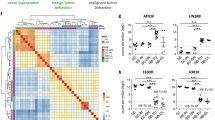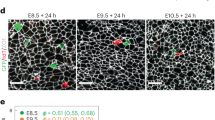Abstract
Both cell growth (cell mass increase) and progression through the cell division cycle are required for sustained cell proliferation1. Proliferating cells in culture tend to double in mass before each division2, but it is not known how growth and division rates are co-ordinated to ensure that cell size is maintained1,3,4,5. The prevailing view is that coordination is achieved because cell growth is rate-limiting for cell-cycle progression6,7,8,9,10. Here, we challenge this view. We have investigated the relationship between cell growth and cell-cycle progression in purified rat Schwann cells, using two extracellular signal proteins that are known to influence these cells11,12,13. We find that glial growth factor (GGF) can stimulate cell-cycle progression without promoting cell growth. We have used this restricted action of GGF to show that, for cultured Schwann cells, cell growth rate alone does not determine the rate of cell-cycle progression and that cell size at division is variable and depends on the concentrations of extracellular signal proteins that stimulate cell-cycle progression, cell growth, or both.
This is a preview of subscription content, access via your institution
Access options
Subscribe to this journal
Receive 12 print issues and online access
$209.00 per year
only $17.42 per issue
Buy this article
- Purchase on Springer Link
- Instant access to full article PDF
Prices may be subject to local taxes which are calculated during checkout




Similar content being viewed by others
References
Su, T. T. & O'Farrell, P. H. Curr. Biol. 8, R687–R689 (1998).
Mitchison, J. M. The Biology of the Cell Cycle (Cambridge Univ. Press, London, 1971).
Coelho, C. M. & Leevers, S. J. J. Cell Sci. 113, 2927–2934 (2000).
Conlon, I. & Raff, M. Cell 96, 235–244 (1999).
Stocker, H. & Hafen, E. Curr. Opin. Genet. Dev. 10, 529–535 (2000).
Fantes, P. A. J. Cell Sci. 24, 51–67 (1977).
Johnston, G. C., Pringle, J. R. & Hartwell, L. H. Exp. Cell Res. 105, 79–98 (1977).
Nurse, P. Phil. Trans. R. Soc. Lond. B 332, 271–276 (1991).
Polymenis, M. & Schmidt, E. V. Curr. Opin. Genet. Dev. 9, 76–80 (1999).
Prescot, D. H. Exp. Cell Res. 11, 86–98 (1956).
Burden, S. & Yarden, Y. Neuron 18, 847–855 (1997).
Cheng, L., Esch, F. S., Marchionni, M. A. & Mudge, A. W. Mol. Cell. Neurosci. 12, 141–156 (1998).
Stewart, H. J. et al. Eur. J. Neurosci. 8, 553–564 (1996).
Ikegami, S. et al. Nature 275, 458–460 (1978).
Dunn, G. A. & Zicha, D. Symp. Soc. Exp. Biol. 47, 91–106 (1993).
Polymenis, M. & Schmidt, E. V. Genes. Dev. 11, 2522–2531 (1997).
Johnston, L. A., Prober, D. A., Edgar, B. A., Eisenman, R. N. & Gallant, P. Cell 98, 779–790 (1999).
Prober, D. A. & Edgar, B. A. Cell 100, 435–446 (2000).
Weinkove, D., Neufeld, T. P., Twardzik, T., Waterfield, M. D. & Leevers, S. J. Curr. Biol. 9, 1019–1029 (1999).
Edgar, B. A. Nature Cell Biol. 1, E191–E193 (1999).
Neufeld, T. P., de la Cruz, A. F., Johnston, L. A. & Edgar, B. A. Cell 93, 1183–1193 (1998).
Cheng, L., Khan, M. & Mudge, A. W. J. Cell Biol. 129, 789–796 (1995).
Acknowledgements
We thank M. Marchionni for the recombinant GGF 2, L. Cheng for her expert help, A. Lloyd, S. Leevers, D. Knight, P. Nurse, R. Brooks and the Raff and Lloyd labs for helpful discussions, and the Medical Research Council for support.
Author information
Authors and Affiliations
Corresponding author
Supplementary information
Supplementary figures
Figure S1 IGF-I but not GGF promotes the growth of quiescent cells in the presence of aphidicolin. (PDF 33 kb)
Figure S2 Cells in IGF-I (100 ng ml -1 ), forskolin and aphidicolin grow at the same rate in high (20 ng ml -1 ) or low (2 ng ml -1 ) GGF.
Figure S3 Cells proliferating in IGF-I, GGF and forskolin become progressively smaller
Rights and permissions
About this article
Cite this article
Conlon, I., Dunn, G., Mudge, A. et al. Extracellular control of cell size. Nat Cell Biol 3, 918–921 (2001). https://doi.org/10.1038/ncb1001-918
Received:
Revised:
Accepted:
Published:
Issue Date:
DOI: https://doi.org/10.1038/ncb1001-918
This article is cited by
-
Live-cell mass profiling: an emerging approach in quantitative biophysics
Nature Methods (2014)
-
Merging high-quality biochemical fractionation with a refined flow cytometry approach to monitor nucleocytoplasmic protein expression throughout the unperturbed mammalian cell cycle
Nature Protocols (2013)
-
The p44/wdr77-dependent cellular proliferation process during lung development is reactivated in lung cancer
Oncogene (2013)
-
Direct observation of mammalian cell growth and size regulation
Nature Methods (2012)
-
Molecular mechanism of size control in development and human diseases
Cell Research (2011)



